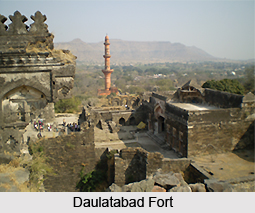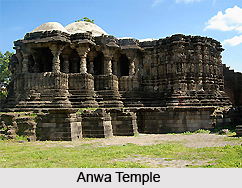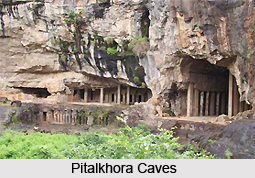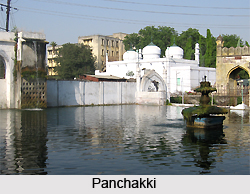 The gateway to the World Heritage Sites of Ajanta and Ellora, Aurangabad is named after the Mughal emperor, Aurangzeb. Lying along the right bank of the Kham River, the city is the district headquarters, which offers visitors all the modern comforts and amenities.There are several luxury and budget hotels, shopping centres and banks. In the city, there are three museums housing the art treasures of the region -- the Sunheri Mahal Museum, the University Museum and the Chhatrapati Shivaji Museum.
The gateway to the World Heritage Sites of Ajanta and Ellora, Aurangabad is named after the Mughal emperor, Aurangzeb. Lying along the right bank of the Kham River, the city is the district headquarters, which offers visitors all the modern comforts and amenities.There are several luxury and budget hotels, shopping centres and banks. In the city, there are three museums housing the art treasures of the region -- the Sunheri Mahal Museum, the University Museum and the Chhatrapati Shivaji Museum.
Daulatabad
Rising dramatically over 600 ft above the Deccan plain is the arresting sight of Daulatabad. Once known as Devgiri, this fort served as the head quarters of the powerful Yadava rulers. In the 13th century, Mohammed bin Tughlak, the Sultan of Delhi, made it his capital and renamed it Daulatabad, or City of Fortune.
One of the world`s best preserved forts of medieval times, surviving virtually unaltered, Daulatabad still displays many of the internal contrivances that made it invincible. A series of secret, quizzical subterranean passages lie amidst the fort. Its defense systems comprised fortifications of double and even triple rows of massive walls. A fortress conquered only by treachery!
The most notable structures at Daulatabad are the Chand Minar, Jami Masjid and royal palaces. The tapering 30-metre high tower of the Chand Minar is divided into four storeys, and was faced with glazed tiles and carved motifs. The Minar probably served as a prayer hall or a victory monument in its time. The Jami Masjid was a mosque built by the Khilji ruler of Delhi, Qutubuddin Mubarak. The palaces consist of spacious halls, pavilions and courtyards. The fort is open till 6 pm.
 Khuldabad
Khuldabad
In the 14th century, several Sufi saints of the Chishti order, chose to reside in Khuldabad or the Abode of Eternity. The dargah, or tomb of Moinuddin Chishti, the spiritual guide of the Mughal emperor, Aurangzeb, is within this sacred complex. The austere emperor himself rests nearby, in a grave as simple as that of a common man`s, in striking contrast to the grand mausoleums of his predecessors. Eloquent testimony to Aurangzeb`s simplicity is the inscription on his plain tombstone: "No marble sheets should shield me from the sky as I lie there one with the earth."
Anwa Temple
A Shiva temple, with beautifully carved sculptures and decorated pillars stands in the village of Anwa, 10 kms east of Golegaon, on the main road leading from Aurangabad to the Ajanta Caves. It was built in the 12th century, and consists of a sanctuary, a mandapa or open hall with decorated pillars. The niches have exquisitely sculpted images of Vishnu, Ganesha and other divinities.
 Pitalkhora Caves
Pitalkhora Caves
Thirteen Buddhist excavations, dating from the 2nd century BC to the 1st century AD lie about 40 km northwest of Ellora, cut into the side of the a secluded ravine. Comprising mainly viharas, they form the largest group of Hinayana Buddhist structures.
Lonar Crater
170 kms from Aurangabad, is the village of Lonar. Over 30,000 years ago, a falling meteorite struck the area creating the world`s largest impact crater in basaltic rock. Botanists have recently discovered vegetation life forms not found anywhere else on this planet, in the stunning lake of the crater.
Here"s a chance to see India"s magnificent hypervelocity meteorite-impact crater. Lonar ranks 3 rd amongst the world"s five largest craters. Investigations reveal it to be around 40,000 years old. Within the depression lies a saline lake.
See the ruins of temples constructed in Hemadanti style, where Lord Narasimha, Ganesh, Renukadevi and Shiva were once worshipped. At the village around the crater, you can listen to many legends about Lonar. A fascinating sight is the presence of hundreds of peafowls, which live inside the crater. Besides other resident and migratory birds, you can spot monitor lizards, Hanuman langoors, chinkaras and gazelles, if you"re lucky.
 Paithan
Paithan
51 kms south of Aurangabad, the looms of Paithan still weave the beautiful Paithani saris that are prized by all Indian women. The town is also famous for the Dnyaneshwar Udyan, which is the largest garden in Maharashtra, and a museum which treasures a fascinating collection of art. The Jaikwadi Dam nearby is a bird-watchers delight.
Bibi ka Maqbara
Built by Azam Shah in 1678, the Bibi ka Maqbara is a son`s loving tribute to his mother, Begum Rabia Durrani, the Queen of Mughal emperor Aurangzeb. Standing spectacularly on the lawns of the landscaped garden with ponds, fountains and water channels, the white marbled monument rises majestically in an intentional bid to copy and rival the world famous Taj Mahal of Agra.
The central tomb, distinguished by elaborate surface ornamentation and intricately perforated marble screens, is framed by four towering minarets.
 Panchakki
Panchakki
An engineering feat of the time is the Panchakki, or the water mill built by Malik Ambar in 1695. The water, channeled from a spring on a distant hill was used to power the flour mill and grind grain for the pilgrims.
Darwazas
Most of the monuments in Aurangabad are of the Nizam Shahi, Mughal and Maratha period. There are four main darwazas, or gates leading into the city, which along with nine secondary darwazas formed part of the defense systems of the city.
The Aurangabad Caves
Though not half as impressive as the ones in Ajanta and Ellora, the Aurangabad Caves provides a fine initiation to rock-cut architecture. Chiselled out of a steep spur of the Sahyadri Range just north of the city, the caves go back to the Vakatakas (4th and 5th century A.D.) and the succeeding Kalachuri dynasties (6th to 8th century), though the older Hinayana cave (Cave 4) is said to date back to at least the 1st century A.D., if not earlier. The location is relaxing and offers magnificient city views.
Caves 1-5, the western caves can be reached via a long flight of stairs from the main road. Cave 2 is a 6th century vihara (cave with cells) with a colonnaded verandah. Exquisitely carved panels include a portrayal of a seated Buddha. The larger Cave 3 has intense friezes picturing scenes from Buddha`s life central chamber. Cave 4 is the oldest chaitya, dating back to 1st century A.D. - a more severe Hinayana phase of architecture.
The eastern caves, Caves 6-10, are around a kilometre by the hillside. They contain some daintily carved Bodhisattvas and sculptures of women with fascinating ornaments and glamorous coifs. Cave 7 is the highlight with colonnaded shrines on both sides of the verandah. The panel to the left of the doorway illustrates Avalo-kitesvara (the Buddha of Compassion) bordered by eight worldly fears - fire, sword, chains, shipwreck, lions, snakes, rampaging elephants and demon of death. The sculptures of bedecked women illustrate the mounting interest in the female form and female creative energy, Shakti. Aurangabad`s most illustrious panel can be witnessed in this cave as well - a frieze demonstrating a dancer in a classical posture with six female musicians.
An unnumbered cave next to Cave 6 was identified in 1961 and has baffled archaeologists since. Ganesha is the focal deity, while the mural to its right bears an image of the Buddha.
Purwar Museum
Dr Shantilal Shankarlal Purwar`s enamoring private collection, on display since 1970, includes a 500-year-old chain mail suit, an 800-year-old Paithani sari and a copy of a Koran, hand-written by Aurangzeb. This charming old haveli is situated near Sharafa Bazaar, just next to Mohan Talkies. Entry is free for every visitor. Timings are from 10 a.m.-6 p.m. It is open on all days.
Getting There
By Air
Aurangabad is the gateway to the region, and is generally where you would arrive or depart from. Aurangabad airport is conveniently located, around 10 kms east of the town, and is directly air-linked to Mumbai, Delhi, Jaipur and Udaipur.
By Rail
Aurangabad is well connected to Mumbai and other cities.There are two trains that depart daily from Mumbai. The Tapovan Express leaves Mumbai early morning arriving in Aurangabad by late afternoon, while the Devgiri Express is an overnight train.
By Road
There are several luxury and state run bus services that ply between Mumbai and Aurangabad and the Ajanta / Ellora Caves.






